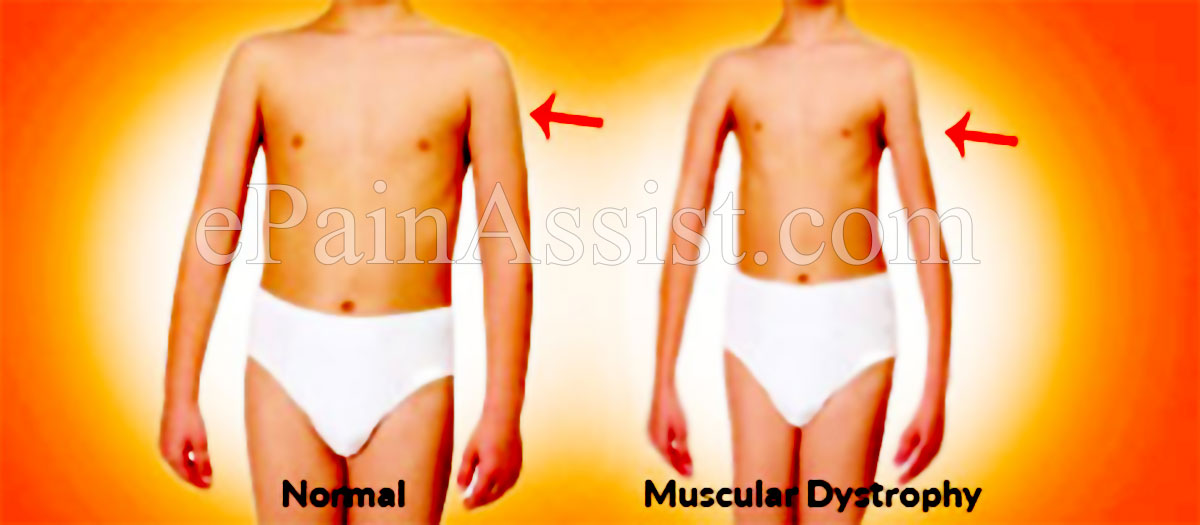Duchenne’s muscular dystrophy is also known as Muscular dystrophy – Duchenne type, and pseudohypertrophic muscular dystrophy.
Duchenne’s muscular dystrophy is one of the nine types of muscular dystrophies. It is a very common and severe type of muscular dystrophy. Duchenne’s muscular dystrophy is an inherited disease that often results in muscle weakness and degeneration with quick progression which continues to the worsening state.1

Duchenne’s muscular dystrophy is a condition which occurs due to absence of dystrophin, which is a protein that assists in keeping the muscle cells intact.1 Symptoms of Duchenne’s muscular dystrophy could be seen in early childhood, generally in the age group of 3 to 5 years. It more often affects boys whereas in girls it is very rare. Duchenne’s muscular dystrophy in girls generally does not exhibit any symptoms.
The symptoms of Duchenne’s muscular dystrophy generally show up around 5 years of age. It starts with affecting the pelvic muscles by weakening them. Children with this kind of disorder often require a wheelchair by the age of 12 years. Following this the muscles of legs, arms, shoulders, and back may also get affected and become weak. Duchenne’s muscular dystrophy may affect the respiratory muscles in the later stages and a ventilator may be needed in order to help with breathing.2
Some children with Duchenne’s muscular dystrophy may even experience learning disabilities while a very few of the affected children may turn out to be disabled intellectually. On the other hand, some individuals may have such mild symptoms that the disease often is not even diagnosed.
It is seen that kids affected with Duchenne muscular dystrophy generally have a life span of about 20 years.
Epidemiology of Duchenne’s Muscular Dystrophy (DMD) or Muscular Dystrophy
Boys are more prone to Duchenne’s muscular dystrophy when compared to girls.3 It could be seen in early childhood, generally in the age group of 3 to 5 years. It approximately affects 1 out of 3,500 boys. Duchenne’s dystrophy patients typically have a life span of about 20 years.
Causes and Risk Factors of Duchenne’s Muscular Dystrophy (DMD) or Muscular Dystrophy
- It is a genetic disorder caused due to the absence of dystrophin that is a protein in the muscles. It usually worsens quickly. Individuals having family history of Duchenne muscular dystrophy are more likely to get affected with the condition.
- Duchenne muscular dystrophy more often affects boys when compared to girls due to the way it is inherited. The sons of women carrying it may have 50 percent risk of developing the disorder whereas daughters of such women have a 50 percent chance of being carriers. However, there are no symptoms seen in these women who are the carriers of it.
- Approximately 1 out of 3600 male infants may get affected with Duchenne muscular dystrophy most of the cases being hereditary.
Signs and Symptoms of Duchenne’s Muscular Dystrophy (DMD) or Muscular Dystrophy
Symptoms of Duchenne’s muscular dystrophy may start showing up as early as infancy and generally start showing up by the age of 6 years.
Common Symptoms Include:
- Mental retardation.
- Weakness in the muscles of the pelvis, legs, neck, arms and other regions of the body.
- Fatigue.
- Learning difficulties.
- Frequent falls.
- Weakness quickly gets worse.
- Difficulty with potential activities like hopping, jumping, and running.
- Difficulty while climbing stairs or getting up from a lying position.
- Progressive difficulty while walking.
- Loss of walking ability may be experienced by age 12.
- Heart disease and breathing difficulties usually begin by 20 years of age.
Treatment of Duchenne’s Muscular Dystrophy (DMD) or Muscular Dystrophy
There is no proper cure available for treating Duchenne muscular dystrophy. Therefore treatment mainly concentrates on improving the quality of life by controlling the symptoms.
Steroid drugs help in slowing down the loss of muscle strength and are initiated at the time of diagnosis or at the point where loss of muscle strength is noted.
Other Treatments Include:
- Carnitine.
- Coenzyme Q10.
- Albuterol.
- Amino acids.
- Vitamin E.
- Green tea extracts.
- Creatine.
- Fish oil.
These treatments are not yet proven to be very much effective in abolishing the symptoms. Gene therapy and stem cells may be used as further treatment.
Physical therapy helps in maintaining strength and function of the muscles. Speech therapy is often required. Inactivity like bed rest often leads to worsening of the disorder.
Other Treatment Modalities Needed May Include:
- Orthopedic appliances like wheelchairs and braces to help in improving mobility.
- Proton pump inhibitors help the patients with gastroesophageal reflux.
- Assisted ventilation used during the day or night time.
- Drugs that help in functioning of the heart may include beta-blockers, diuretics and angiotensin-converting-enzyme inhibitors.
Investigations for Duchenne’s Muscular Dystrophy (DMD) or Muscular Dystrophy
A thorough subjective and neurological check up along with lungs, heart and muscle examination is required. Common findings on examination are:
- Deformities of the back and chest such as scoliosis.
- Enlarged muscles of the shoulders, buttocks and calves in the age group of 4 to 5 years.
- Abnormal heart muscle also known as cardiomyopathy.
- Irregular heart rhythm and congestive heart failure.
- Muscle deformities.
- Respiratory disorders like pneumonia
- Poor swallowing.
- Passing of the fluids or food into the lungs is seen in later stages of the disease.
- Loss of muscle mass.
- Muscle contractures in the legs and heels.
Diagnostic Tests May Include:
- Muscle biopsy.
- Serum CPK.
- EMG.
- Genetic tests.
